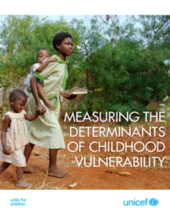This study by UNICEF sought to identify key determinants of vulnerability among children –including those affected by HIV and AIDS – that can contribute to developing an improved global measure of vulnerable children in the context of HIV and AIDS. Data from the most recent available household surveys at the time of analysis was used from 11 countries – Cambodia, Central African Republic, Haiti, Malawi, Rwanda, Sierra Leone, Swaziland, Uganda, United Republic of Tanzania, Zambia and Zimbabwe – were pooled.
Based on the results of the pooled analysis, the key indicators of vulnerability for children and adolescents can be consistently identified as household wealth, a child’s household living arrangements, and the education level of adults in the household. Orphanhood was found also to be significant for some developmental outcomes and continues to be a useful proxy of HIV affectedness, particularly in high HIV prevalence settings.

